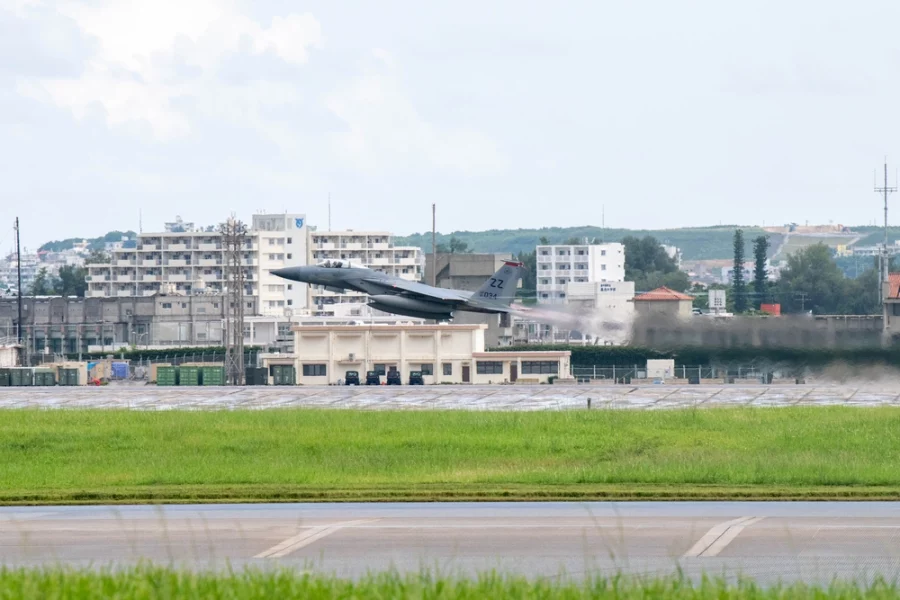A four-ship of F-15Cs departed Kadena Air Base on Okinawa, Japan, Aug. 24, leaving only a small number of Eagles still on the island after 40 years of being the Air Force’s tip of the spear in the Indo-Pacific. Service officials said the remaining Eagles will depart “soon.”
Meanwhile, the initial cadre of F-15EXs, which will eventually replace the F-15C/Ds at Kadena, has been declared operational in Oregon, and contracts for further lots of Eagle IIs are close to being made final.
“The four-ship’s departure marks just one milestone on the road to replacing the F-15C Eagles and ushering in a new era of air superiority with the F-15EX Eagle IIs,” the 18th Wing at Kadena said in a press release.
Without offering details, the 18th Wing said some of the aircraft that departed Aug. 26 will go to the “Boneyard” at Davis Monthan Air Force Base, Ariz., while others “will be used at other Air Force units.”
On Aug. 15, the wing put out a release noting that one of its F-15Cs had conducted its last flight ever before being dismantled at Kadena and shipped back to the U.S. Presumably, its structural condition is so fragile that it could not be flown across the Pacific. The jets date back to the 1980s and ’90s, and have become increasingly structurally- and speed-limited as they have flown beyond their planned service lives.
“The final flight of the remaining F-15C Eagles out of Kadena is yet to be determined,” the 18th Wing said.
The Air Force raised eyebrows when it announced in October 2022 that it would phase out its F-15s from Kadena over the next two years without an immediate replacement in hand. A rotation of fighters including F-15Es, F-16s, F-35s, and F-22s has supplemented the force on Okinawa as the F-15C/D cohort has drawn down.
“As we divest the F-15 C/Ds, we remain committed to a phase-in/phase-out approach with backfill aircraft to maintain presence and operational readiness,” a Pacific Air Forces spokesperson said.
In July, the Pentagon announced the permanent replacement for the 48 F-15C/Ds of the 44th and 67th Fighter Squadrons on Okinawa would be 36 F-15EXs. Though 12 fewer, the new aircraft boast additional weapon stations, new electronic warfare suites, fly-by-wire flight controls, a far more powerful set of processors, and new cockpit displays. The notional date for fully equipping Kadena with the F-15EX is 2026.
The Air Force’s very first operational F-15EX arrived at Portland Air National Guard Base, Ore., in June. When the second fighter arrived shortly thereafter, Air Combat Command boss Gen. Kenneth Wilsbach, declared Initial Operational Capability for the type. It’s the first time the Air National Guard has gotten a new-type fighter before the Active-Duty force.
Declaring IOC was one element of “a significant year of accomplishments” for the F-15EX, Brig. Gen. Jason D. Voorheis, program executive officer for fighters and advanced aircraft, said at USAF’s Life Cycle Industry Days conference on July 29.
“Boeing successfully delivered the first eight F-15EX Lot 1 production aircraft,” he said. Six went to Eglin Air Force Base, Fla., for combined initial and developmental operational test and evaluation, while the other two went to the Portland Air Guard.
“Additional aircraft will deliver … starting in January 2025, from Lot 2,” and those deliveries will begin once Boeing completes production of the F-15QA for Qatar, on which the F-15EX is based.
The Air Force has divested 105 F-15C/Ds so far and if Congress permits, will divest another 77 next year, Voorhis noted.
He said Air Force acquisition executive Andrew Hunter approved full-rate production of the F-15EX in June, and “we’re very close to finishing negotiations with Boeing on both Lot 5 and Lot 6 production.”
The AN/ALQ-250 Eagle Passive Active Warning Survivability System (EPAWSS), the electronic warfare suite that will protect the F-15EX—which is not a stealthy aircraft—has completed test and evaluation “with very positive results from the operational test community,” Voorheis reported. The first F-15 equipped with EPAWSS went through Boeing’s modification line in San Antonio, Texas, in June, and has since gone to Nellis Air Force Base, Nev., he said.
The Air Force initially planned a fleet of 144 F-15EXs, but in the fiscal 2025 budget proposed limiting the fleet to just 98 aircraft. Congress may direct otherwise: the House Armed Services Committee, in its version of the 2025 budget, directed the purchase of an additional 24 aircraft, for a total fleet of 122 Eagle IIs. The budget has yet to be resolved and passed by Congress.
